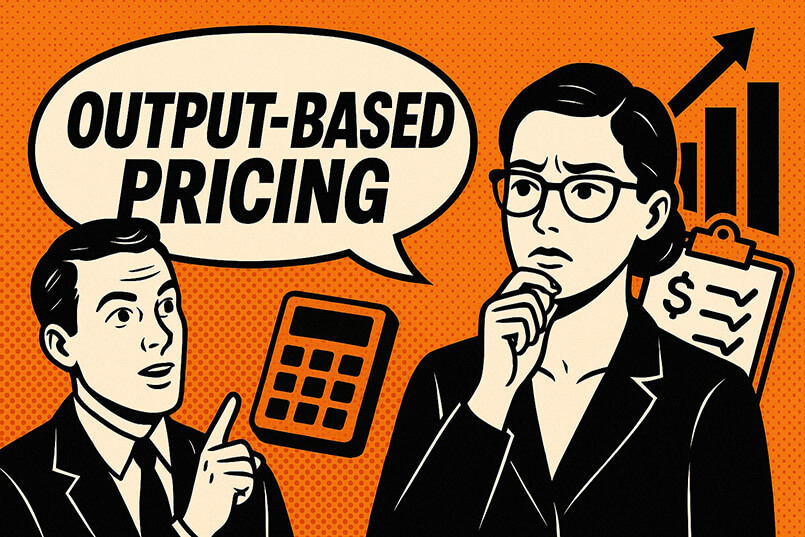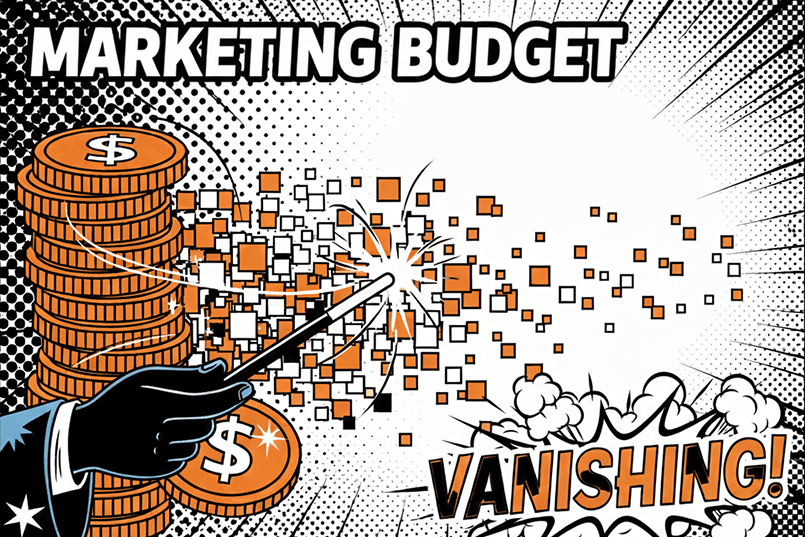While input models, such as hourly rates, retainers and project fees, continue to dominate agency fees, there is an increasing interest in output-based pricing models, driven primarily by the impact of AI technology on agency productivity.
However, several issues affecting marketers and their agencies hinder the adoption of this output-based approach. One issue we will explore here is the implementation of this output model.
Output-based pricing
Unlike hourly rates and retainers, which are determined by the cost of inputs (human resources), the output-based pricing model assigns a price based on the value of what those resources produce (the outputs or deliverables). This should not be confused with the outcome fee model, which relies on the value of the outcomes delivered, such as leads, sales, or any other measurable and valuable outcome.
Both outputs and outcomes are integral to a value-based approach to agency fees. Here, we will focus on the output model, which assigns a value or price to a deliverable. These deliverables can be tangible or intangible, such as a static social media update (tangible) or the social media strategy of which that update is an output (intangible).
There are several approaches to setting this value-based pricing. While the underlying cost to the agency can be a starting point, the price for that deliverable is also determined by the value of that deliverable to the client’s marketing and business, the level of complexity, the scale of the work, the expectation of quality, and more.
Common misunderstandings
It is natural to assume that when an agency fee model is based on defining and pricing the value of the deliverable, rather than on the number and cost of the hours required to produce it, this approach is best suited for project-based work. This is a common misnomer regarding output-based pricing models.
While project forms of work are becoming more common, the approach to setting the agency fee still takes a cost input approach: defining the scope of the project (often in the broadest possible terms), proposing the level and mix of the agency resources required to deliver that work, and calculating the cost of those resources to propose a fee.
But imagine if you believe that even a retained agency relationship is merely about undertaking a series of projects throughout the year? In many ways, all agency relationships ultimately result in both tangible and intangible deliverables, whether they are project-based or retained.
The issues for marketers and agencies
The move to project-based work has created issues for marketers and their agencies that also impact the uptake of value-based pricing.
For marketers, this includes:
- More project management time is needed to brief the agency on a project-by-project basis and to manage cost estimates, approvals, and purchase orders for each project.
- Due to the fee model, the agency relationship becomes increasingly transactional, resulting in a diminished perception of the agency as a ‘partner’.
- Managing a more fragmented approach to cost management when marketing budgets are either static or falling, and the scopes of work are increasing.
For agencies, this includes:
- Agencies are already informing clients, transitioning from a retainer model to project fees, that it will be increasingly challenging to maintain a dedicated human resources team for their businesses. This challenge is exacerbated by the cost recovery approach employed by agencies.
- The loss of retainers and increased project fees also undermine the agencies’ cash flow certainty, making revenue loss less predictable.
- Agencies need to increase margins to create trading buffers against this uncertainty in a highly competitive market with constant downward price pressure from marketers.
If you think an output-based fee model is ideal for project-based work only, you are missing a significant opportunity. While the model lends itself to project-type work with agencies, the output pricing model can also be used for a fee model that overcomes many of the issues and challenges of project work and can be applied to create a more accountable retainer-type agency fee model.
We have created output fee models for clients that act more like an agency subscription model rather than an agency project fee or retainer. This process overcomes all of the challenges and issues above for both marketers and their agencies.
An agency subscription fee model
We have written about and explored subscription fee models in the past. They are ideal for marketers with a consistent volume and scope of work for their agency, but they can be a challenge if their agency requirements are patchy or seasonal, in which case, a project fee arrangement is better.
Subscription models are incredibly popular in technology, publishing, services, and more. There is no reason that the same approach cannot be applied to the supply of agency services. The subscription model provides the marketer with a range of agency services paid on a monthly fee with the option of increasing or decreasing the subscription level going forward to meet their changing needs.
It can be a standalone fee model or part of a hybrid approach to agency fees. The benefit is that it provides certainty of cost for marketers and cash flow for agencies and yet can accommodate changes in the scope mix and value with a flexible future-facing approach.
How to establish a subscription model
The process involves defining the broadest range of outputs or deliverables required from the agency. You can easily identify the requirements by reviewing the deliverables from the past 12 months or two years. Using our VerificomTM toolkit, we can calculate the typical market fee for thousands of nuanced outputs across all major markets and industry categories, from finance to retail to consumer-packaged goods.
This becomes a menu of services or outputs, both tangible and intangible, with a price assigned to each deliverable. Some of these services can be packaged to provide a price for the delivery of a collection of services or outputs that commonly sit together to ensure the pricing reflects any economies of scale within those packages.
These prices are proposed, negotiated, and agreed upon, providing a priced menu of services, much like a restaurant’s à la carte menu. This negates the need to enter each project from scratch, as the marketer orders each service from the menu. This resembles a project-based approach, but with pre-agreed pricing. And it is. Implementation shifts this into a subscription model.
Applying the subscription model
Looking a year ahead, what do you need your agency to deliver in terms of outputs? If that is too far in the future to determine, what about the next six months? Or the next three months? By using either your marketing plan or your historical needs, you can project a scope of work for the agency. Then, using the pricing menu, you can sum the agreed fees for each required menu item to calculate the agency fees for the upcoming period. This is the agency fee.
As you will see, the actual amount is not critical to the success of the subscription-based model because, like all good subscription models, there is an opportunity to increase or decrease the subscription from the base level going forward. This flexibility is also important for marketers who need to adjust the scope of work throughout the year.
However, a subscription model allows you to pay for those services monthly. Therefore, divide the agency fee by the number of months the scope of work was calculated. If that period is six months, divide by six. For twelve months, the division is by twelve, and so forth. The agency then keeps track of the work you brief them on and the outputs they deliver.
Once you reach the monthly subscription level, you and the agency have two options. The first is to stop any new work with the agency until the next month, or you can upgrade the monthly subscription to a higher fee level to cover the additional work.
But if you do not use the full value of the subscription service in any month, it will not be returned to you. Your choices would be to downgrade your subscription level if you believed you would not need the level you were subscribed to going forward. Or the agency could agree to allow you to carry a credit as you advance.
You can read more about our VerificomTM toolkit here. You can download the Advertising Agency Fees – A Comprehensive Guide for Marketing here. Or contact us to discuss the best agency fee model for your agency arrangements.




